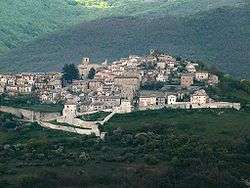Monteleone di Spoleto
| Monteleone di Spoleto | ||
|---|---|---|
| Comune | ||
| Comune di Monteleone di Spoleto | ||
|
View of Monteleone di Spoleto | ||
| ||
 Monteleone di Spoleto Location of Monteleone di Spoleto in Italy | ||
| Coordinates: 42°39′5″N 12°57′6″E / 42.65139°N 12.95167°E | ||
| Country | Italy | |
| Region | Umbria | |
| Province | Perugia (PG) | |
| Frazioni | Butino, Rescia, Ruscio, Trivio | |
| Government | ||
| • Mayor | Nando Durastanti | |
| Area | ||
| • Total | 61.58 km2 (23.78 sq mi) | |
| Elevation | 978 m (3,209 ft) | |
| Population (28 February 2010)[1] | ||
| • Total | 648 | |
| • Density | 11/km2 (27/sq mi) | |
| Demonym(s) | Monteleonesi | |
| Time zone | CET (UTC+1) | |
| • Summer (DST) | CEST (UTC+2) | |
| Postal code | 06045 | |
| Dialing code | 0743 | |
| Patron saint | St. Nicholas | |
| Saint day | 6 December | |
| Website | Official website | |
Monteleone di Spoleto (in Antiquity, the Roman town of Brufa), is a town and comune of Italy, in the province of Perugia in southeast Umbria at 978 meters (3209 ft) above sea-level overhanging the upper valley of the Corno River. It is one of the more remote towns in Umbria, on a mountain road from Norcia and Cascia (33 km and 12 km NNE respectively) to Leonessa and Rieti in the Lazio (10 km S and 51 km SSW).
The population of the comune was 648 in 2010, with the town proper accounting for about half of that; the frazioni of Monteleone are Butino, Rescia, Ruscio, and Trivio.
Monteleone is famous for one of the world's great archaeological finds: a 6th‑century BC Etruscan chariot that quickly followed the path of money and by the early 20th century had already wound up in the Metropolitan Museum in New York. A copy of the chariot is on display in Monteleone. There remain, however, few if any traces of the town's Roman days: destroyed and rebuilt by the Spoletans in the 12th century, it offers at present an essentially medieval appearance.
The main monument in Monteleone is the 14th-century church of San Francesco, with a cloister now serving as a lapidary museum, a Gothic door and a fresco of Christ crucified in the full robes of a bishop, with a loaf of bread under one foot and a chalice of wine under the other. Under the cloister a second church can be seen, complete with a 14th‑century fresco. Other monuments include several other medieval churches, the 15th‑century Palazzo Bernabò, and vestiges of the town's medieval walls, including a clock tower.
References
External links
| Wikimedia Commons has media related to Monteleone di Spoleto. |
- Pro Loco (The town's volunteer tourist bureau)
- Archeoambiente
